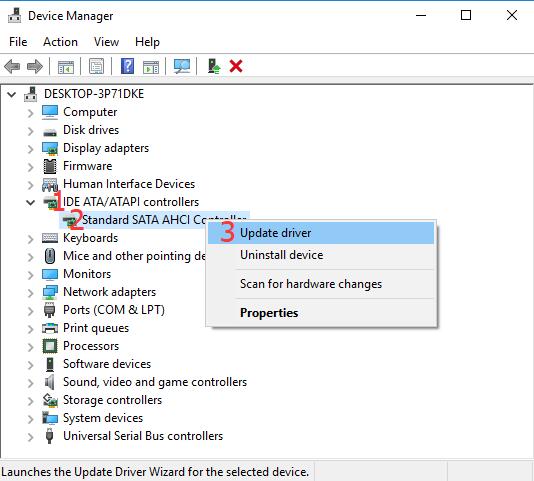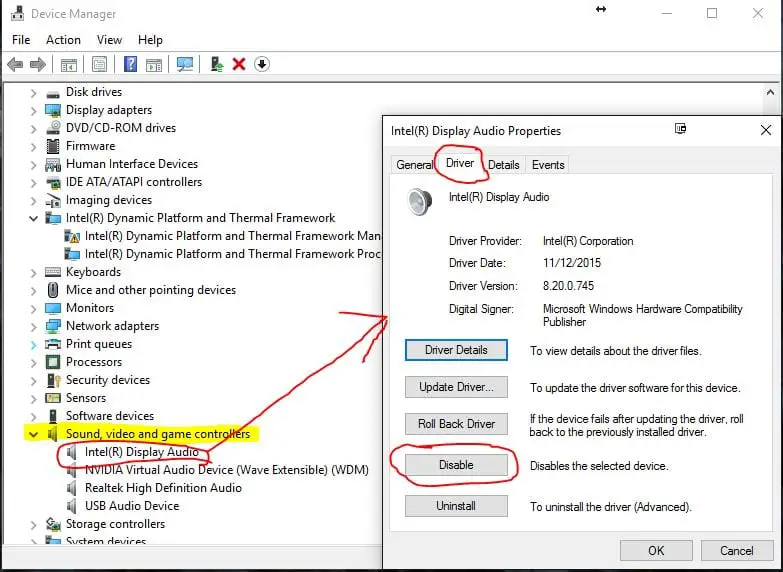On Windows 7, by default, we install a single driver for most of Adafruit's boards, including the Feather 32u4, the Feather M0, Feather M0, Express, Circuit Playground, Circuit Playground Express, Gemma M0, Trinket M0, Metro M0 Express. On Windows 10 that driver is not necessary (it's built in to Windows) and it will not be listed. 1 thought on “ How to switch from IDE to AHCI in Windows 10 ” MichaelM March 13, 2017 at 4:47 am The booting into safe mode really stimulated win10 to update the drivers in a dual boot situation where previously, although I had changed the registry for pciide and Storahci, the system remained in ide mode. Download arduino ide for windows 10 for free. Development Tools downloads - Arduino by Antipasto and many more programs are available for instant and free download.
An old operating system like Windows 7 or XP is using IDE, but with Windows 10, you have to use Standard SATA AHCI Controller Driver. Also Read: How to Rollback Nvidia Drivers in Windows 10 It is always important and recommended to keep Standard SATA AHCI controller driver up-to-date to keep SATA drives healthy and prevent crashes. Here's what the HP driver site says for Windows 10: it only list Official HP driver support for Windows 8 as shown. Windows 10 drivers may be available through Windows Update. Click 'Learn More' below for steps on using Windows Update to determine what drivers might be available for your product. Its common that one needs to use a programmer from the Arduino IDE, but on Windows 10 things are not as simple. Many times the drivers installed are not correct hence the avrdude tool in the Arduino IDE refuses to work. Now, we have a way to do this programming in Linux as well.
09 Jun 2018, 12:00am TZ +00:00
Its common that one needs to use a programmer from the Arduino IDE, but onWindows 10 things are not as simple. Many times the drivers installed are notcorrect hence the avrdude tool in the Arduino IDE refuses to work.
Now, we have a way to do this programming in Linux as well.Have a look at my latest articleProgramming Arduino Bootloader using Avrdude with AVRISP mkII in Manjaro (Arch Linux).
Here we would look at a way to make that possible.
The idea would be first to get the Libusb-Win32 driver installed which isessential for the avrdude to work.

Note: In case you have AtmelStudio installed this might have difficultly,due to the presence of the Jungo WinUSB driver. We would look into movingaround that. Custom rom zip file download for android.
Let’s assume that on the PC we have the following situation:
- No drivers installed for AVRISP mkII
- We have Admin access
- We have internet available
Getting Libusb-win32#
The libusb-win32 package available from Sourceforge.
We just need to download the latest available release version of the package.
Currently it is libusb-win32-bin-1.2.6.0.zip as on June 2018.
Make sure to get something on the similar lines.
If you do not find, just go the Files section of the Sourceforge and go to the libusb-win32-releases folder. Select the latest version folder anddownload the file similar to the above.
Setting Up Driver#
Next, unarchive / unzip the Zip file libusb-win32-bin-1.2.6.0.zip as on June 2018.
Inside would be a directory structure similar to :
1. Open bin directory.#
2. There in execute the inf-wizard.exe after connecting the AVRISP mkII.#
3. Press the Next button.#
4. Select the AVRISP mkII in the list#
The Ids would be -
VendorID: 0x03EB
ProductID: 0x2104
Click Next to start the Ini creation process
5. Device Configuration#
Do Not Touch this
Click Next to Proceed.
6. Save the INI file#
Next it would ask to save an INI file with the name AVRISP_mkII.inf
Create A directory Named AVRISP_mkII-Driver.
Navigate to this directory and then Click on Save.
Next Click on Done to continue.
7. The Driver Directory#
It should look something like
Disable the Driver Signing check#
We would be disabling the Driver signing check temporarily.
Hold Shift and select Restart from the Start menu.This would enter the advance setup mode.
In Advanced Setup mode : Select Troubleshoot ->Advance Options
In Advanced Options click on See more recovery options
Next Startup Settings - This would reboot the PC and come to anotherreboot screen displaying options with function keys to select them.
Press F7 this would select to Disable Driver Signature Enforcement -Again the system would reboot into normal windows.
Now Open the Device Manager : Right click the AVRISP mkII under Other devices and select Update driver.
Select the Directory Location where we earlier stored the generated driver.
Windows 10 would show Warning about driver having no signature.Don’t worry its not a problem just select Install Anyway…
Now you should be able to see libusb-win32 devices under which theAVRISP mkII is present in Device Manager
We need to restore the Driver signing. Open an Administrator Command Prompt.
In Administrator Command Prompt Type Command :
BCDEDIT /set nointegritychecks OFFThis would re-Enable the Disable Driver Signature EnforcementReboot the PC normally.
Note: The Easy way to the enable and disable Driver Signature EnforcementAre 2 commands for an Administrator Command Prompt:
- To disable device driver signing, type
BCDEDIT /set nointegritychecks ONthen press Enter - To enable device driver signing, type
BCDEDIT /set nointegritychecks OFFthen press Enter
Finally#
This completes the Installation of the Driver.
Now we can try and check in the Arduino IDE if the avrdude interface works withAVRISP mkII
The generated Driver is included here.
The first time using a new microcontroller is what I call funstrating, especially if you don’t have clear instructions. We’ve done the hard work of figuring out the NodeMCU drivers and NodeMCU Arduino IDE setup for you. Read on for the two steps that have to be done only once. More helpful info at the end, too.
Installing NodeMCU drivers for USB
This part of the instructions are written for Windows. They’re very similar for OSX and Linux.
Mostly these days devices download and install drivers on their own, automagically. Unfortunately as of writing this post when I plug a brand new NodeMCU into a new Windows 10 installation with a micro USB cable I get a warning message that says “USB Device Not Recognized – Device Descriptor Request Failed”.
Windows doesn’t know how to talk to the USB driver on the NodeMCU so it can’t figure out that the board is a NodeMCU and proceed normally. You’ll need to download the official driver and install it yourself.
The official NodeMCU drivers are here.
Ide Drivers For Windows 10 32-bit
Download and extract the files, then run the Windows 10 installer. NodeMCU should now appear as a COM port on your Windows 10 computer.
Please post OSX-specific instructions them in the comments below.
Upgrade Arduino Boards Manager
We’re almost done! This next bit is pretty easy. Arduino has a list of possible microcontrollers (boards) that it can support if you ask it to add support. This does two useful things: it keeps the download smaller for them (less $) and it means new users are not swamped with lots of options they may never use. We need to add NodeMCU to the list of possible microcontrollers and then tell Arduion “Please download and install support for NodeMCU.” https://cardever283.weebly.com/blog/animate-cc-mac-download-free.
Fire up Arduino IDE and go to File > Preferences. /super-bluetooth-hacker-apk-for-android-free-download.html.
In the field that says “Additional Boards Manager URLs” add “http://arduino.esp8266.com/stable/package_esp8266com_index.json” and hit OK. Now your Arduino IDE knows that NodeMCU boards exist.

go to Tools > Boards > Boards Manager
There are a lot of boards here! In the search field type “esp8266”, which is the name of the Wifi module at the heart of the NodeMCU.
You can see in my copy I’ve already installed the plugin. Click once anywhere on the description text. A button labelled “install” will appear nearby. The location is inconsistent, and IMHO the button should always be visible if the plugin has not been installed. Click it and the installation process will begin. As of this writing it has to download ~150mb of data. Once it’s done, close the Boards Manager.
To back to Tools > Boards and you will find the list is now quite a bit longer.
Choose your flavor of NodeMCU (probably 1.0 ESP-12E Module) and start coding.
NodeMCU example sketches
Examples for any given board type should appear under File > Examples. Examples are tailored to the type of board that you have currently selected. If you don’t see any NodeMCU or ESP examples, double check that you have Tools > Boards > [your NodeMCU flavor] selected. One time I changed board type to UNO and all my NodeMCU examples vanished. So confusing!
Final thoughts
Ide Atapi Controllers Windows 10
- Sketch upload time is long compared to UNO or Mega. Still worth it!
- When using digitalWrite(), use digitalWrite(D0) instead of digitalWrite(0) and so on. Pin mapping on the NodeMCU is weird.
- Wifi sketches need the SSID and password of your local Wifi network in order to connect. In the top of most sketches you’ll find a field “….” that should be replaced with your wifi SSID and/or wifi password.
See Also
Ide Drivers For Windows 10 Pro
[products skus=’ELEC-0108, ELEC-0041, ELEC-0111′]